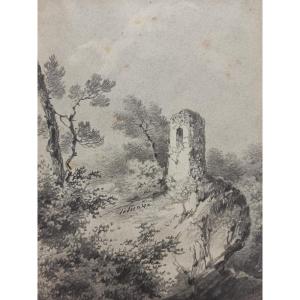Figures on the banks of a canal in Burgundy, circa 1890-1900
Pencil, pen and brown ink wash on paper
Signed in ink lower left "A. Legros"
30.2 x 45.7 cm
On the verso, collection mark "LAL", stamped in black ink (not in Lugt); numbered 24 (in pencil, circled), title in pencil "Canal près de Dijon" and words "(from Miss Marie F. Legros)".
Very good condition, with light spotting in the sky (see photographs)
Presented as is, in sheet form
Provenance: Descendants of the artist ; Private collection, France
Comparatives:
National Gallery of Art, Washington - drawing, 1906 : https://www.nga.gov/collection/art-object-page.37034.html
Royal Academy, London - drawing, 1905 : https://www.royalacademy.org.uk/art-artists/work-of-art/burgundy-landscape
* * *
The draughtsman, engraver and painter Alphonse Legros was born in Dijon in 1837. Through his artistic training in Paris, in the workshop of Horace Lecoq de Boisbaudran, he became friends with Fantin-Latour and James Abbott McNeill Whistler, with whom he shared an attachment to the realistic work of Gustave Courbet and a commitment to the practice and defence of etching. Together they formed the "Société des Trois". Whistler encouraged Legros to move to London, which he did in 1863, and he began to exhibit his work there regularly at the same time as in Paris.
In England, his talent and his vision of art quickly brought him into line with Dante Gabriel Rossetti, Lawrence Alma-Tadema and Burne-Jones, among others, and he quickly achieved success with his art, which perhaps baffled French art lovers too much - although the finest critics of the time, Baudelaire, Duranty, Astruc and Champfleury, appreciated him and continued to encourage him.
Alphonse Legros was the central artist in the exhibition presented at the Petit Palais in 2018, entitled "The Impressionists in London - French Artists in Exile, 1870-1904". For his French colleagues arriving in London, he was the first contact across the Channel and the cornerstone of their community: Carpeaux, Jules Dalou. Jean-Charles Cazin, Léon Lhermitte and François Bonvin, among others.
In 1876, Legros was appointed Professor at the Slade School of Fine Art, where he worked to emphasise the importance of drawing, engraving and knowledge of the Old Masters. Throughout his career, the art of Alphonse Legros remained strongly inspired by the realism of Millet and Courbet and by the profound and majestic poetry of the Old Masters.
This is reflected in this drawing, which evokes Rembrandt's landscape engravings, Bonington's English Romanticism and nineteenth-century French realism. This vast landscape in pencil and brown ink wash can be seen and felt as a vision, a distant evocation under the hand of the artist who grew up in similar places in Burgundy and who has drawn on his memories, mingled with a vague strangeness, to invent this scene in all the shades of brown ink. Legros composes with sensitivity, without any real anecdote, for the pleasure of conveying an atmosphere made up of rustles, streams and peasant murmurs.
This drawing could be dated to around 1890-1900. This was the artist's period when, having finally retired from his role as teacher, he fully rediscovered the pleasure of free, imaginative drawing (see the comparative works mentioned above).
Alphonse Legros's drawings and engravings are held in the finest museums, from the Louvre to the British Museum, including the National Gallery in Washington, the Royal Academy in London and the Metropolitan Museum in New York.
This drawing is very well preserved and is full of the poetry that is so unique to Alphonse Legros.























 Le Magazine de PROANTIC
Le Magazine de PROANTIC TRÉSORS Magazine
TRÉSORS Magazine Rivista Artiquariato
Rivista Artiquariato
